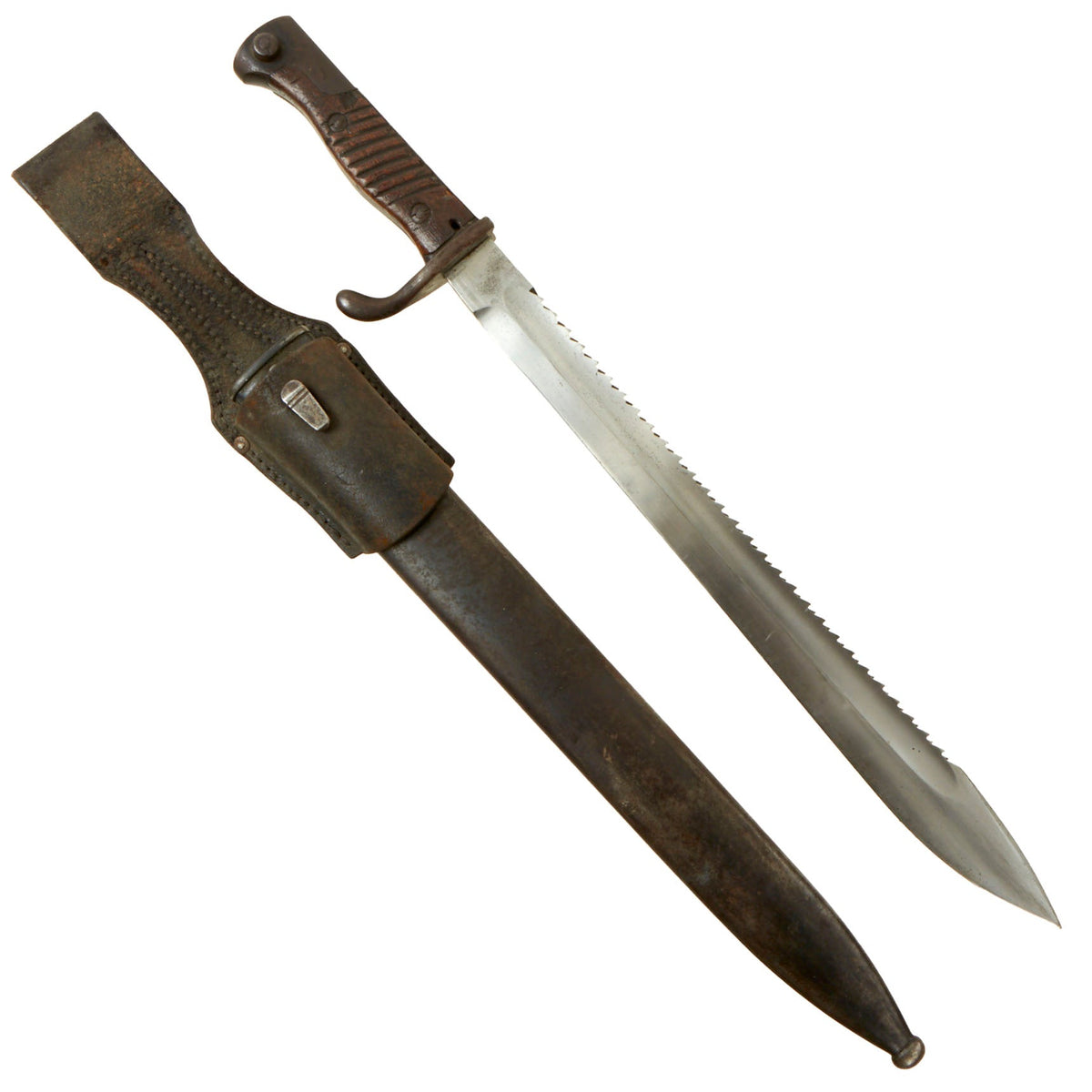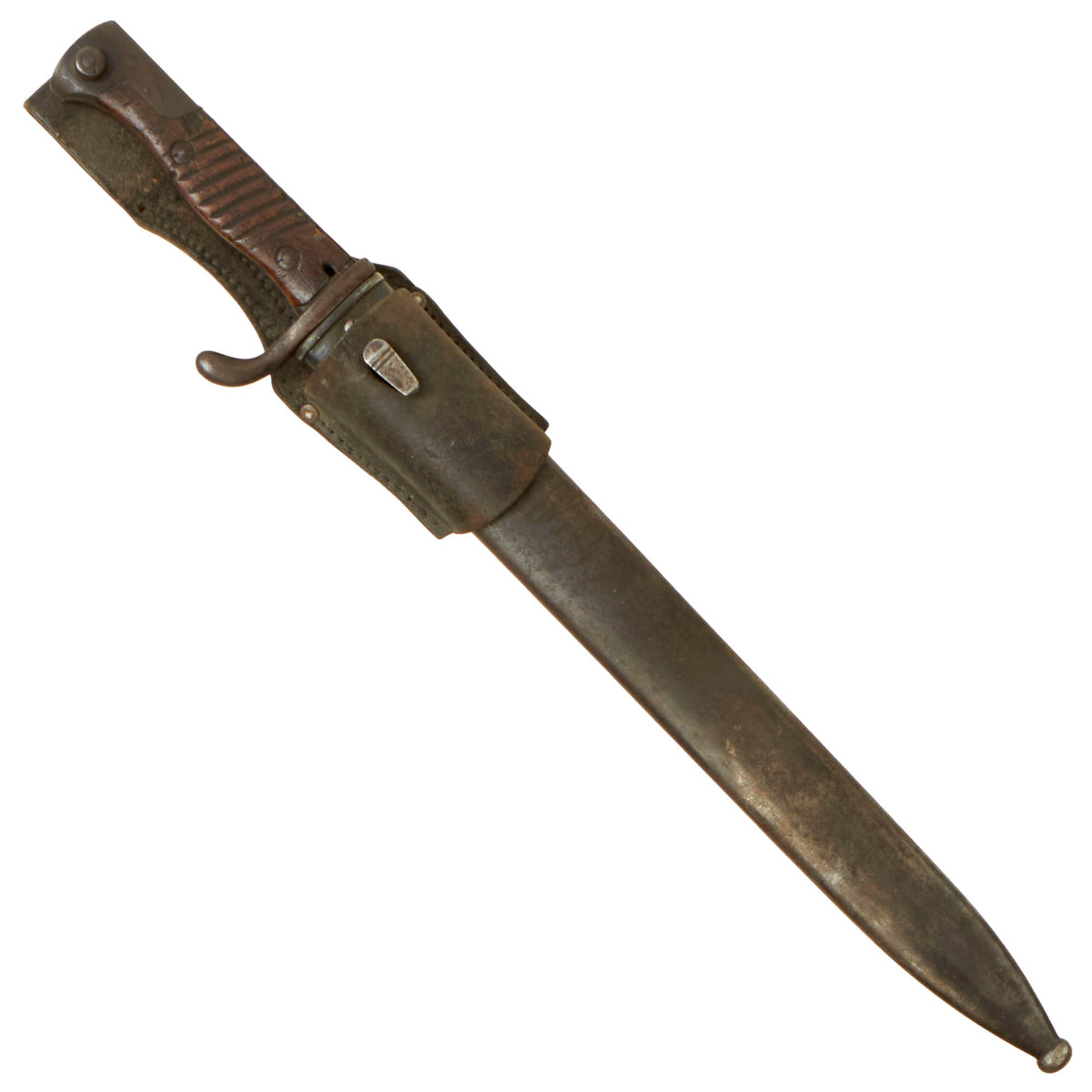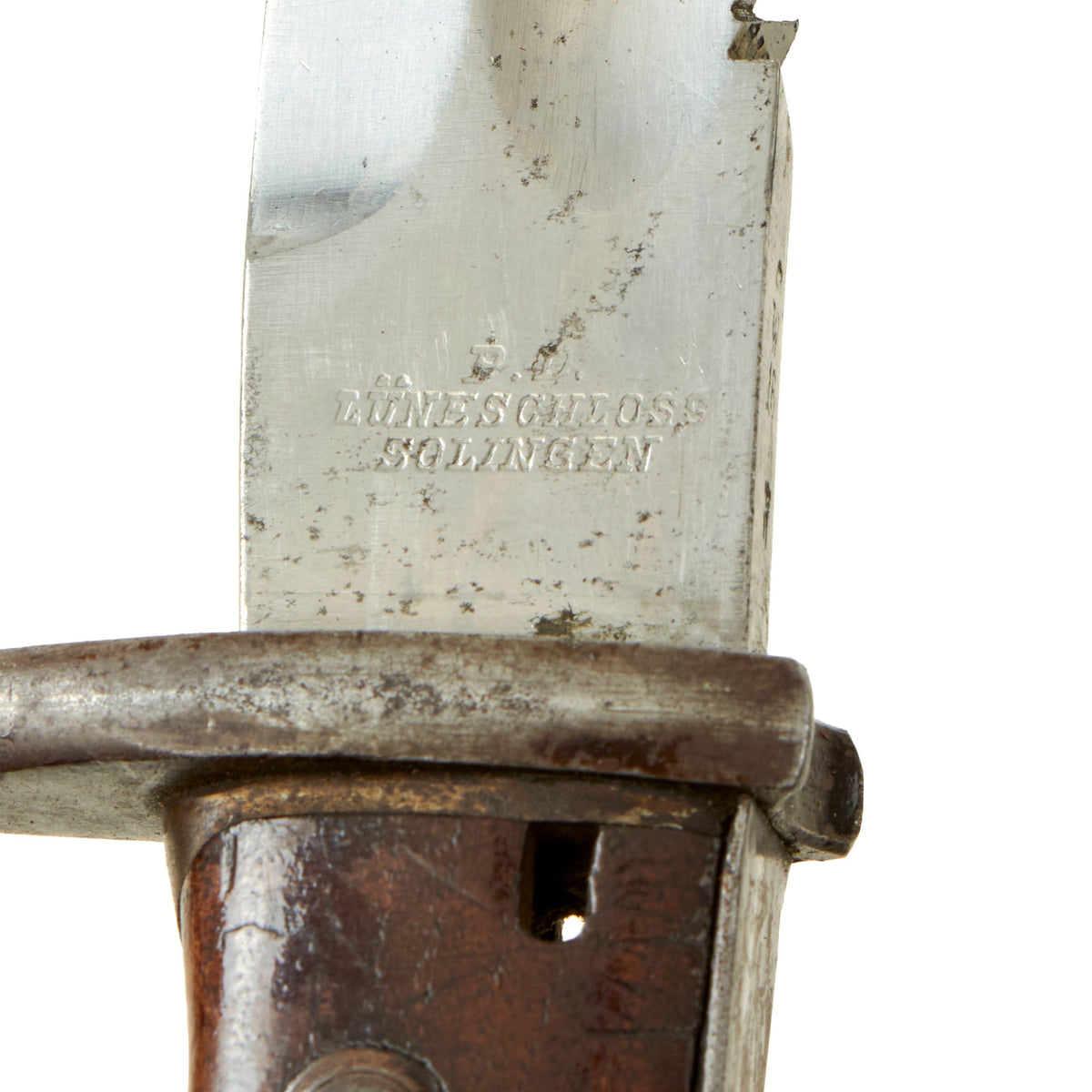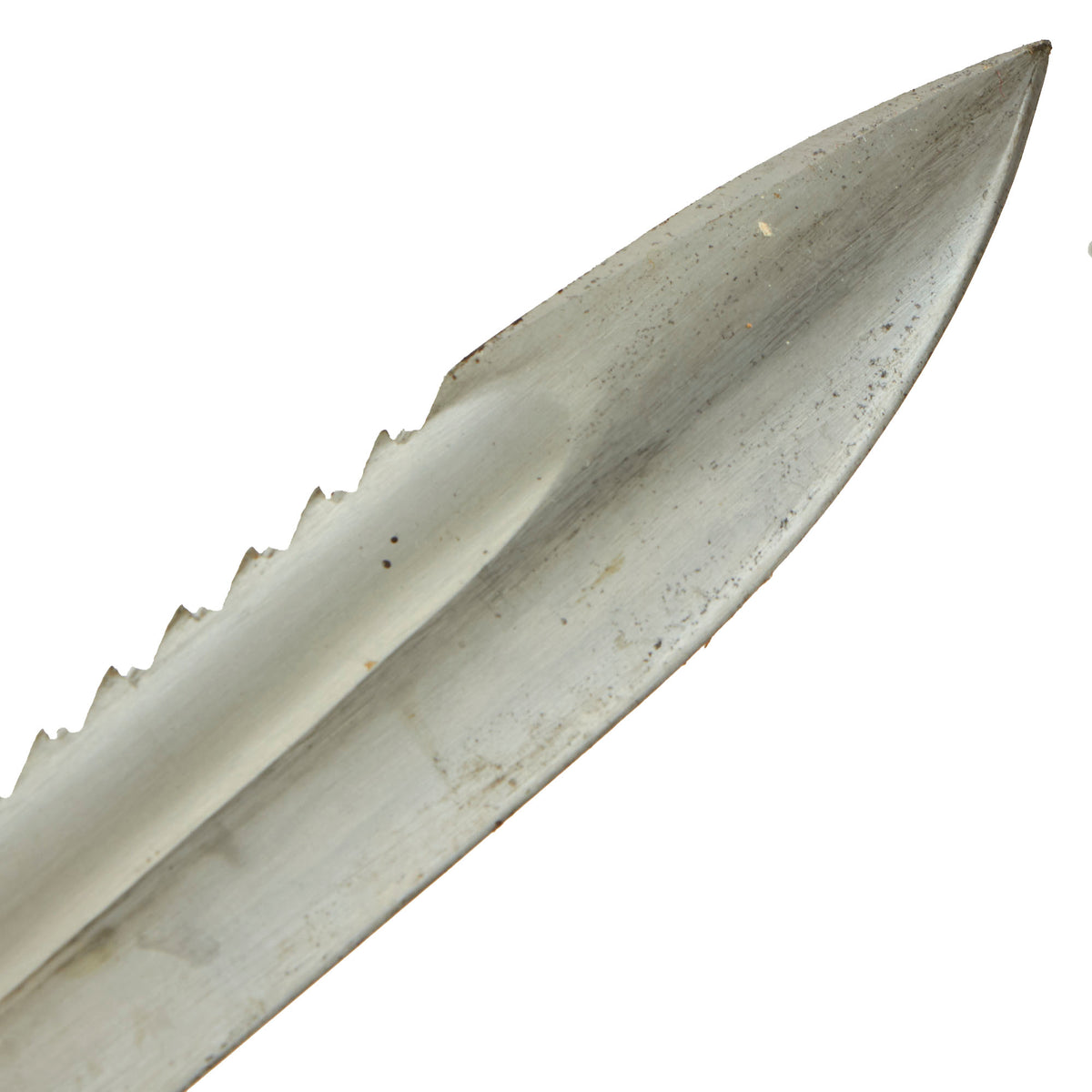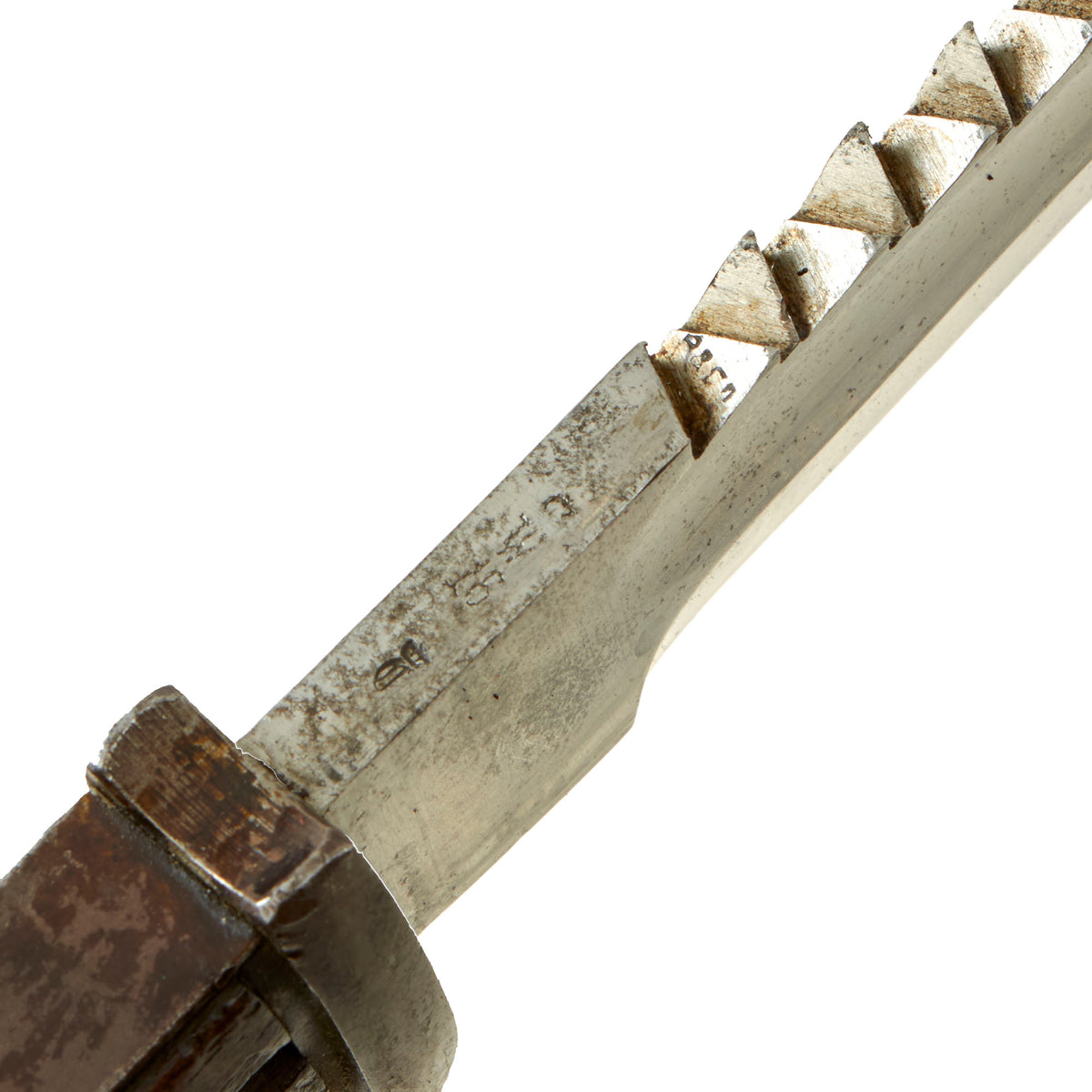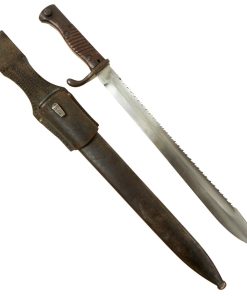Original German WWI M1898/05 n/A Butcher Sawback Bayonet by P.D. Lüneschloss Solingen with Scabbard & Frog – 1916 Dated Original Items
$ 595,00 $ 178,50
Original Item. Only One Available. This is a great example of the M-1898/05 Bayonet (Seitengewehr), which was the most common German Bayonet of the First World War. It was intended for use on the standard issue service rifle of Imperial Germany: the Mauser-designed Gewehr 98 (GEW 98). It features a heavy 14.5-inch steel blade with distinct bulge toward the point, giving extra weight and power to the business end, known as a “butcher blade”. This version is known as n/A (neuer Art = newer model). This second pattern lacks the first pattern’s vestigial muzzle ring (or ‘ears’) and has a flashguard on the back of the grip.
This example has a very desirable “sawback” blade, which was intended for use by pioneers to saw through brush and obstacles. Unfortunately a rumor got out that it was intended to inflict grievous harm on enemies, so a lot of the sawback bayonets had this feature removed, making them hard to find. This example has a blade in very good condition. There is a bit of light staining, but no major rust issues. It does not appear to have been sharpened much, and the sawback itself is in good condition.
This example has a very nice set of original grooved wood grips that have a lovely color and heavy chipping from time, with a very nice hilt with some heavy oxidation and a great patina. Bayonet lock is fully functional, and the flash guard is undented, which is rare as these were often used as a hammer in the field. The guard does have some oxidation which is to be expected. The blade in general looks to be uncleaned, with minor pitting in specific spots. The blade ricasso is maker marked (top line faint):
P. D.
LÜNESCHLOSS
SOLINGEN
The well-known P.D. Lüneschloss, Fabrik blanker Waffen (Factory of Bare Weapons) company was founded in 1810 by Peter Daniel Lüneschloss. It originally began as a cutlery manufacturer but started the production of edged weapons in 1848. During the American Civil War of 1861-65, Lüneschloss supplied edged weapons to both Federal and Confederate forces, though definitely supplied more to the former. The company began producing bayonets in 1860, and had various contracts for them around the world, per J. Anthony Carter’s work GERMAN KNIFE AND SWORD MAKERS.
The blade is dated on the blade’s spine with 1916 and 2 visible proof marks, one of which may be Ottoman. The blade is in very good condition, with the original arsenal sharpening, which is still mostly intact, with only a bit of wear. The original blued finish is completely faded, and there is a bunch of light surface rust on the blade, which could be easily cleaned away. We have left it intact to preserve the lovely patina.
The steel scabbard is in very good condition, with just a few small dents, and without any major rust and also appears to have been cleaned. The body of the scabbard does have pitting present throughout. The frog button is still intact and unbent. Th frog itself is in great shape with patina that pairs well with the bayonet itself. There appears to have been a stamp on the back, but it has worn away with time.
An excellent example of what is becoming a difficult bayonet to find in such fine condition, never messed with, just the way we like to find them. Ready to display.
Dimensions:
Blade length: 14 1/2”
Blade Style: Single Edged “Butcher” with Fuller & Sawback
Overall length: 19 3/4”
Crossguard: 2 3/4”
Scabbard length: 15 1/4″
Frog length: 9 ⅛”
Fast Shipping with Professional Packaging
Thanks to our longstanding association with UPS FedEx DHL, and other major international carriers, we are able to provide a range of shipping options. Our warehouse staff is expertly trained and will wrap your products according to our exact and precise specifications. Prior to shipping, your goods will be thoroughly examined and securely secured. We ship to thousands clients each day across multiple countries. This shows how we're dedicated to be the largest retailer on the internet. Warehouses and distribution centres can be located throughout Europe as well as the USA.
Note: Orders with more than one item will be assigned a processing date depending on the item.
Before shipping before shipping, we'll conduct a thorough inspection of the items you have ordered. Today, the majority of orders will be delivered within 48 hours. The delivery time will be between 3-7 days.
Returns
The stock is dynamic and we cannot completely manage it because multiple stakeholders are involved, including our factory and warehouse. So the actual stock may alter at any time. It's possible that you may not receive your order once the order has been made.
Our policy is valid for a period of 30 days. If you don't receive the product within 30 days, we are not able to issue a refund or an exchange.
You can only return an item if it is unused and in the same state as the day you received it. You must have the item in its original packaging.
Related products
Uncategorized
Band of Brothers ORIGINAL GERMAN WWII Le. F.H. 18 10.5cm ARTILLERY PIECE Original Items
Uncategorized
Uncategorized
Australian WWII Owen MK1 Machine Carbine SMG Custom Fabricated Replica with Sling Original Items
Uncategorized
Armored Burgonet Helmet & Polearm from Scottish Castle Leith Hall Circa 1700 Original Items
Uncategorized
Uncategorized
Uncategorized
Uncategorized
Angolan Rebel 1970s era 60mm Inert Display Mortar from Angolan Civil War Original Items
Uncategorized
Uncategorized
Uncategorized
Uncategorized
Uncategorized
Uncategorized
Uncategorized
Uncategorized
Uncategorized
Uncategorized
